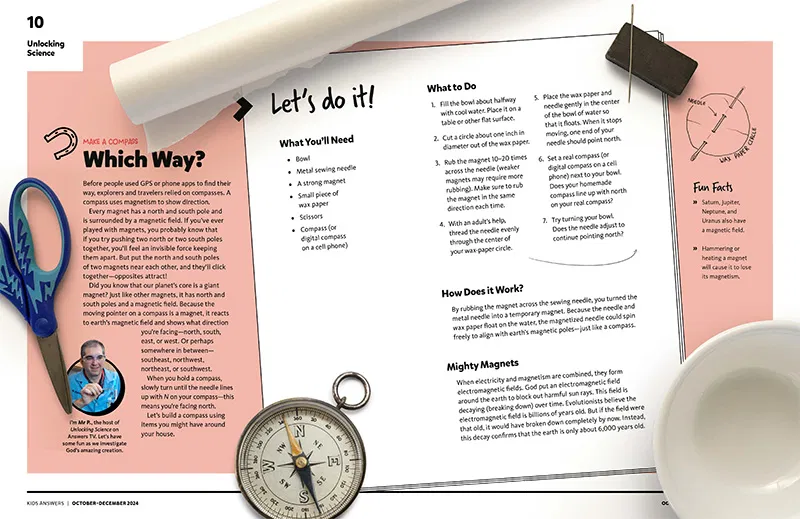Which Way?
Unlocking Science
by Roger Patterson on October 1, 2024Before people used GPS or phone apps to find their way, explorers and travelers relied on compasses. A compass uses magnetism to show direction.
Every magnet has a north and south pole and is surrounded by a magnetic field. If you’ve ever played with magnets, you probably know that if you try pushing two north or two south poles together, you’ll feel an invisible force keeping them apart. But put the north and south poles of two magnets near each other, and they’ll click together—opposites attract!
Did you know that our planet’s core is a giant magnet? Just like other magnets, it has north and south poles and a magnetic field. Because the moving pointer on a compass is a magnet, it reacts to earth’s magnetic field and shows what direction you’re facing—north, south, east, or west. Or perhaps somewhere in between—southeast, northwest, northeast, or southwest.
When you hold a compass, slowly turn until the needle lines up with N on your compass—this means you’re facing north.
Let’s build a compass using items you might have around your house.
Let’s Do It!
What You’ll Need
- Bowl
- Metal sewing needle
- A strong magnet
- Small piece of wax paper
- Scissors
- Compass (or digital compass on a cell phone)
What to Do
- Fill the bowl about halfway with cool water. Place it on a table or other flat surface.
- Cut a circle about one inch in diameter out of the wax paper.
- Rub the magnet 10–20 times across the needle (weaker magnets may require more rubbing). Make sure to rub the magnet in the same direction each time.
- With an adult’s help, thread the needle evenly through the center of your wax-paper circle.
- Place the wax paper and needle gently in the center of the bowl of water so that it floats. When it stops moving, one end of your needle should point north.
- Set a real compass (or digital compass on a cell phone) next to your bowl. Does your homemade compass line up with north on your real compass?
- Try turning your bowl. Does the needle adjust to continue pointing north?
Fun Facts
- Saturn, Jupiter, Neptune, and Uranus also have a magnetic field.
- Hammering or heating a magnet will cause it to lose its magnetism.
How Does It Work?
By rubbing the magnet across the sewing needle, you turned the metal needle into a temporary magnet. Because the needle and wax paper float on the water, the magnetized needle could spin freely to align with earth’s magnetic poles—just like a compass.
Mighty Magnets
When electricity and magnetism are combined, they form electromagnetic fields. God put an electromagnetic field around the earth to block out harmful sun rays. This field is decaying (breaking down) over time. Evolutionists believe the electromagnetic field is billions of years old. But if the field were that old, it would have broken down completely by now. Instead, this decay confirms that the earth is only about 6,000 years old.
Kids Answers Magazine
The Wild History of Horses
Today, horses in all sizes and colors gallop across the world—but what do all these breeds have in common?
Browse Kids Issue- © 2025 Answers in Genesis
- Privacy Policy
- Contact
- About


